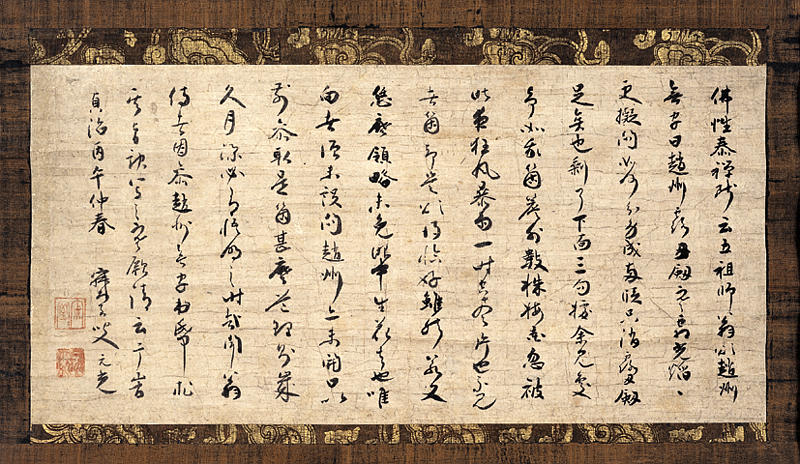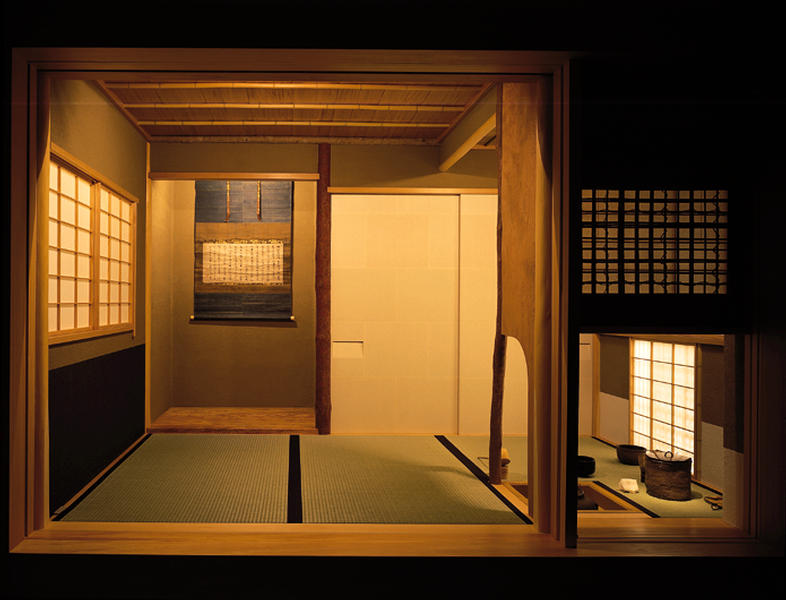Budhist Sermon, by Jakushitsu Genko
- Eigenji temple, Shiga pref.
- Nambokucho period
- 14c
- Hanging scroll, ink on paper
- H-28.6 W-58.9
Catalogue Entry
by Jakushitsu Genko
Nambokucho period, 14th century (dated 1366)
Hanging scroll, ink on paper
Height, 28.6cm; width, 58.9cm
Jakushitsu Genko (1290-1367) was born in Takada, Mimasaka, and in his youth studied with Mui Shogen at Yamashiro Sanshoji. In 1304 (Kagen 2), he took the Buddhist tonsure. Genko then traveled to the Kanto area where he became the disciple of Yakuo Tokken of Sagami Zenkoji, and Yakuo bestowed the anmyo name of Genko upon him. When Yakuo moved to Ken'-ninji in 1307 (Tokuji 2), Genko traveled to Kyoto, accompanying Yakuo to Kenchoji and Nanzenji.
In 1320 (Gen'o 2), at the age of 31, Genko traveled to China where he became the disciple of Zhongfeng Mingben (Chuho Myohon), and Zhongfeng granted him the dogo name of Jakushitsu. Genko then attended a number of famous Zen masters, including Gulin Qingmao, and returned to Japan in 1326 (Karyaku 1). For the next approximately 35 years, he lived in seclusion between Bisshu and Sakushu, also living at times at Mino Tofukuji and Kai Seiunji. In 1360 (Enbun 5), at the age of 71, he responded to an invitation from Sasaki, the lord of Omi, and the following year founded Eigenji in Omi, thus handing on the Buddhist teachings he had learned from Yakuo. While he had continued to petition the shogunal government to the Gozan government temples (Shozan, Jussatsu, Gozan), these requests were completely rejected, and Genko ended his life as a simple ordinary priest. He died on the 1st day of the 9th month of 1367 (Joji 6) at the age of 78. Upon his death his following scattered, and his temple was bequeathed entirely to the members of the village. Genko had gained this honest, integrity-filled demeanor from his encounter with Zhongfeng Mingben, and many people treasure these examples of his poetry and calligraphy.
The present sermon is Jakushitsu Genko's transmission of the sermon in response to a request from the seekers after truth (Mon'o Jisha) who received a koan of Joshu Muji. Genko quotes Bussho Hotai of the Southern Song in his interpretation of Joshu Muji's meaning, but the text by Bussho Hotai quoted in this sermon cannot be located in the writings of Bussho Hotai in the Zokukosonshukugoyo.
Bussho had first attended Wu-tsu Fayen and later inherited the teachings of Fayen's successor, K'o Ch'in (Engo Kokugon), and thus he was able to recall with familiarity Fayen's teachings with Shio. A gatha verse eulogizing Joshu Muji was translated by Fayen. Bussho commented on the first line of this gatha, comparing it to an image of his own device and thus displayed his own talents.
Jakushitsu wrote this sermon out in 1366 (Joji 5), the year before his death. This sermon is recorded in the second volume of Eigen Jakushitsu Osho goroku, and thus we know that it was transmitted to the seekers after truth. In addition, this Joshu-zenji is known for his sermon "Kissako" and is thus revered by tea masters. MK

